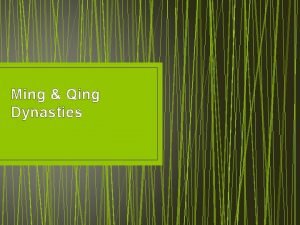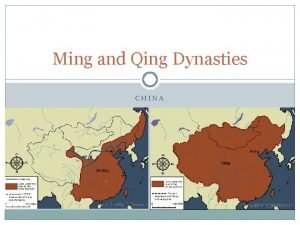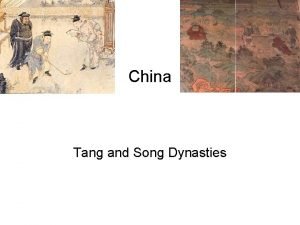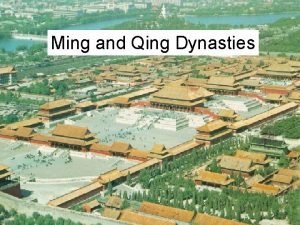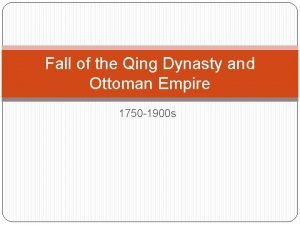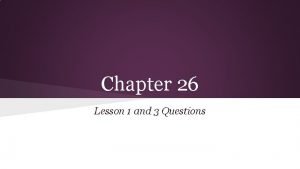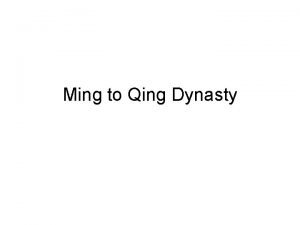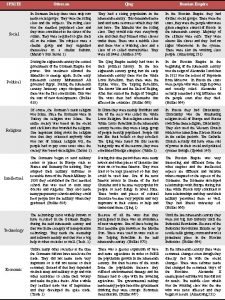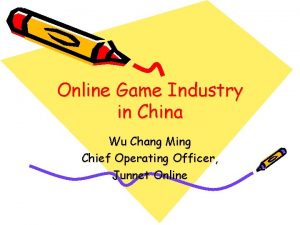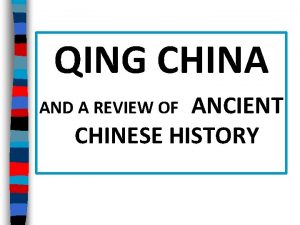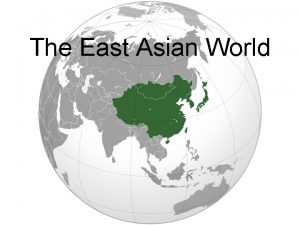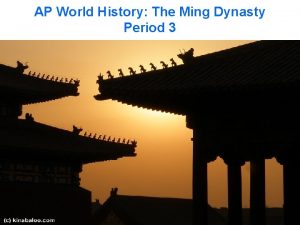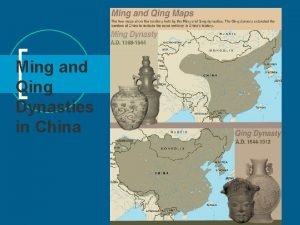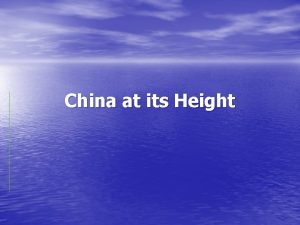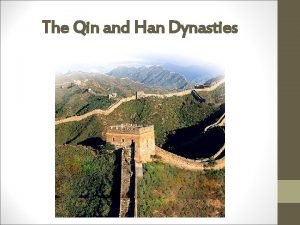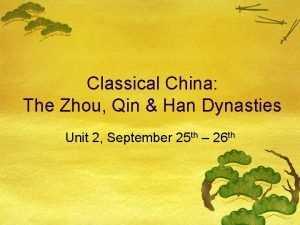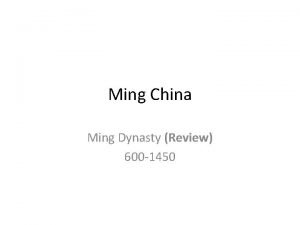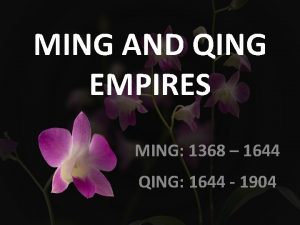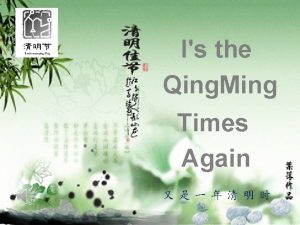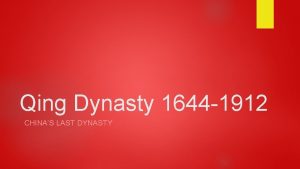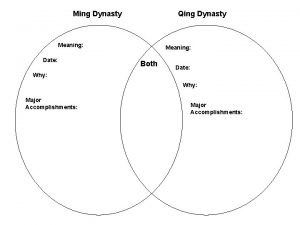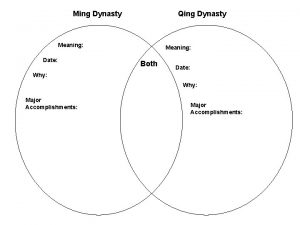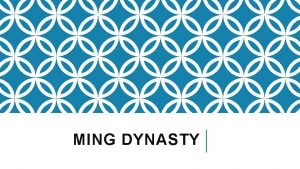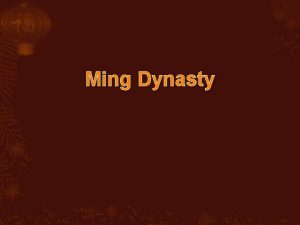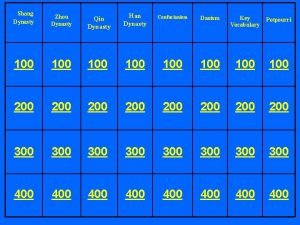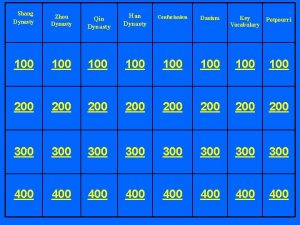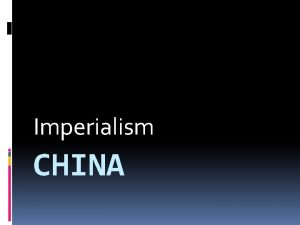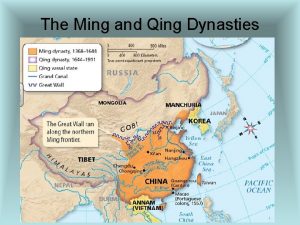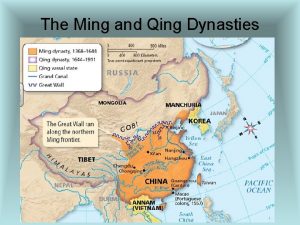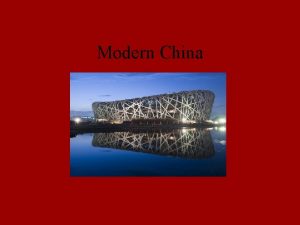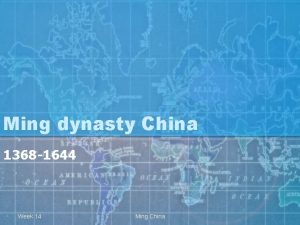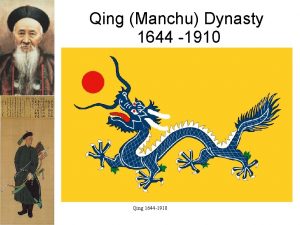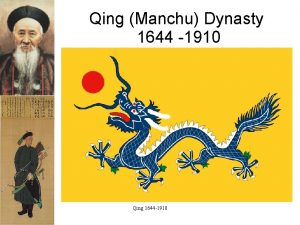China The Ming Through the Qing Dynasty Great























- Slides: 23

China: The Ming Through the Qing Dynasty Great wealth is from heaven; modest wealth is from diligence. Chinese Folk Saying

What is a Dynasty?

Ming China, 1388 -1644 Began with the overthrow of the hated Mongols, who ruled China for 100 years. Founded by the peasant Zhu Yuanzhang who took the imperial title Hongwu (meaning The Generous Warrior) built the city of Nanjing (Nanking) as the capital near the coast of the Yangtze river. (Why a river? ) His son Yongle, ruled from 1402 -1424 Yongle increased China’s territory, rebuilt part of the Great Wall and triumphed against Mongol and Turkish opponents

The Emperors: Hongwu and Yongle

The Great Wall of China The Wall

Ming Economic Progress, Urbanization & Technology population of increased; need for larger food supply New crops introduced from the Americas: corn, squash, peanuts and beans from trading with the Portuguese and Spanish starting in the 1500’s Europeans traded silver from the Americas for luxurious goods from China Increase in people living in urban centers; one or two cities may have even had a population of 1 million

Chinese Technology Continued… great “commerical” revolution through trade of its goods, but never jumped to an “industrial revolution”. valued artists and scholars, held little value for accumulating material goods. (Remember Confucius and Laozi) Great Chinese inventions included: fireworks, gunpowder, the compass, spaghetti, kites, cast iron tools, harnessed animals, blast furnace, acupuncture, paper, printing press, silk harvesting

The Ming Political System The Mandate of Heaven 4 Principles of the Mandate of Heaven 1. The right to rule is granted by Heaven. 2. There is only one Heaven therefore there can be only one ruler. 3. The right to rule is based on the virtue of the ruler. 4. The right to rule is not limited to one dynasty. The ruler is all-powerful, but not divine (or a God), their power comes from the divine. The Ming system of government had a highly trained bureaucracy (a government of departments)

The Ming Political System Emperor Hongwu created a corps of palace workers, men without families, raised since boyhood to be dedicated servants to the ruler. (sound similar? ) Direct access to the emperor and often had great authority Led to some abuses of power, and these men were feared and hated. The Capital was Beijing in the center was the Forbidden City, a quarter square mile of great palaces, offices and living quarters for high officials. No ordinary person could ever enter its walls.

The Forbidden City

The Forbidden City

Chinese Civil Service: group of workers hired to carry out the government’s work. Entry into the system required mastery of the Confucian philosophy and ethics. System of examinations; influenced Chinese education; kept the curriculum to a very narrow range. Schooling was designed to prepare students for civil service examination

Dealing with Foreigners The Mongols and other nomadic peoples continued to menace China’s northern and northwestern frontiers during the Ming Dynasty. The Ming Dynasty spent most of its military budget maintaining the 2, 000 mile long Great Wall. A huge army of over a million was kept at the ready. This time was a high point in cultural and commercial exchange with Japan. Dealings with the Portuguese were so upsetting to the Chinese that they were limited to doing business in one port, Macao.

Journal Entry: Look closely at this painting. Give a brief description of the scene. What is going on? Who is important in the scene? Where and when do you think it is taking place?

Maritime Expeditions/Zheng He Background Information: 1405 -1433: The Chinese emperor sent huge sailing fleets to the East Indies and as far west as the Coast of Africa led by the Admiral Zheng He was China’s great explorer, just as Columbus and Magellan were to Europe. Zheng He was a Muslim who worked for and was a friend of the Emperor Yongle since childhood. Zheng He (who was given the title Admiral) led 7 voyages of the Chinese fleets. The main purpose of these expeditions was to show China’s might and exact tribute from other nations. What is tribute? …………

The Chinese fleet was successful due to superior ship design, advanced seamanship and equipment. Unlike its European counterparts, the Ming Dynasty never established colonies or trading posts as part of its explorations, this was not the intended purpose. In 1433 the age of maritime exploration suddenly ended. The Chinese then had limited contact with westerners, mostly Dutch and Portuguese traders and Spanish or Roman missionaries.

The Voyages of Zheng He

Decline of the Ming Dynasty String of ineffective emperors who allowed the government power to slip to the corps of palace workers. The corrupt cliques of palace workers made it impossible for the government to function. Some government officials believed in an extreme version of Confucianism that rejected innovation. There were rebellions throughout China in response to the lack of leadership. Manzhou tribesman, who admired Chinese culture, took advantage of the rebellions and promised to be good leaders. Manzhou invaders finally take over and founded the last most successful Chinese dynasty, The Qing (Pure).

Qing Dynasty/Government 1644 -1911 Under the Qing Dynasty China had the largest territory and population under one government of any country in the world at the time. The Manzhou had been close to Chinese culture for many years, so the transition of the new dynasty was relatively easy. Most Ming officials and generals voluntarily joined the conquerors. High positions in central and provincial governments were held by two officials: one Manzhou and one Chinese. The army was sharply divided by the ethnic groups and Manzhou had superior status and were called Bannermen. The early years of the Dynasty brought reform, order and respect for authority

The Great Emperors of the Qing Kangxi Longest ruler in Chinese history 1662 -1722. Quick intellect, great administrator. Retained traditional Chinese system of 6 ministries of govt. Improved waterways, canals and dams. Active economic policy. Opened 4 ports to westerners and allowed them to live there. Qienlong Kangxi’sgrandson. Ruled from 1736 -1795. Great warrior and administrator. Rid China of its border problems with Mongol raiders. Brought Tibet under Chinese control for the first time.

Kangxi and Qienlong

Qing Culture and Economy The most respected cultural activities were philosophy, history, calligraphy, poetry and painting. In literature, novel writing became popular. Porcelain artistry was sought all over the world as fine “china” tableware. Painting on scrolls and screens were popular and sought after. China had a large number of educated people. Schools educated the children of anyone who could afford the fees. They chose to focus on fine arts and turned away from technology. This would have a negative affect when faced with the Western world in more modern times.

Progress Under the Qing Dynasty Improvements in agriculture and engineering. Improved internal trade among cities in China. Large numbers of shopkeepers, market porters, carters, artisans and moneylenders. All part of the “commercial” life. Circulation of money (coins). Problems Eventually the size of the population was so large that it was difficult to feed. Limited trade with the outside world. Limited machine industry made farming and competition with the western world difficult.
 Rise of the qing dynasty
Rise of the qing dynasty Ming empire
Ming empire Tang vs song dynasty venn diagram
Tang vs song dynasty venn diagram The ming dynasty ended rule of china.
The ming dynasty ended rule of china. Qing qing hardware contacts
Qing qing hardware contacts Qing conquest of the ming
Qing conquest of the ming Ming dynasty social structure
Ming dynasty social structure China opium war political cartoon
China opium war political cartoon Qing empire decline
Qing empire decline Chapter 26 lesson 1 the decline of the qing dynasty
Chapter 26 lesson 1 the decline of the qing dynasty Qing dynasty dbq
Qing dynasty dbq Qing at its height
Qing at its height Qing dynasty social classes
Qing dynasty social classes Spice chart
Spice chart Ming dynasty game online
Ming dynasty game online Bureaucracy
Bureaucracy The wing dynasty menu
The wing dynasty menu Rise of the ming dynasty
Rise of the ming dynasty Ap world
Ap world Ming dynasty
Ming dynasty China at its height
China at its height China qin dynasty map
China qin dynasty map Ancient china roads
Ancient china roads China zhou dynasty
China zhou dynasty
